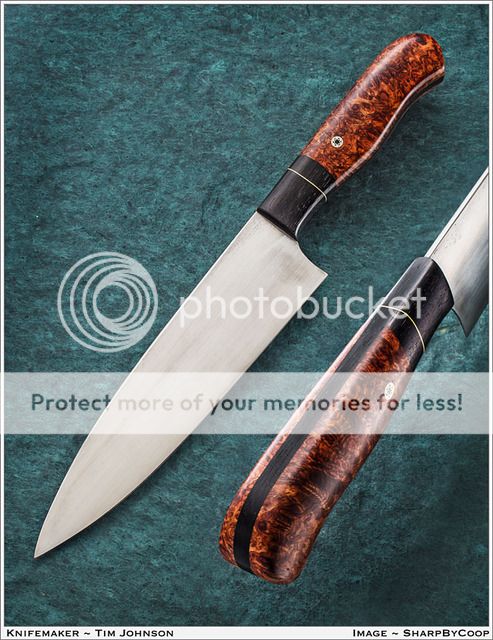timos-
Knifemaker / Craftsman / Service Provider
- Joined
- Oct 22, 2012
- Messages
- 2,212
This is not my first attempt at grinding a gyuto but it is the first one I have "finished".
Back in the day I was attending a design class and the Prof. nearly failed me on a project. I had 4 different boxes filled with different textures and smells. One box was filled with pennies and one penny in particular had a small hole drilled through it. He immediately saw it and said it was inexcusable and he would have given me a perfect grade if it was not for that one aprticular penny so he gave me a D- instead. I think he was trying to teach me a lesson and I think I may still have not learned this lesson. In any case this piece represents my finest work thus far. Please comment and criticize as this knife is meant to be both good looking and functional. The particular duty it is to excel at is a pinch grip cutting boneless chicken (customer request).
Specs:
210 mm blade length
Handle Construction is essentially hidden tang.
Bog Oak Frame and bolsters.
Amboyna Burl dovetailed scales.
Mosaic Pin and brass spacer.
West systems Marine Epoxy was used to join the woods and seal the tang.
The Mosaic Pin holds the entire thing together the glue just seals everything out.

Back in the day I was attending a design class and the Prof. nearly failed me on a project. I had 4 different boxes filled with different textures and smells. One box was filled with pennies and one penny in particular had a small hole drilled through it. He immediately saw it and said it was inexcusable and he would have given me a perfect grade if it was not for that one aprticular penny so he gave me a D- instead. I think he was trying to teach me a lesson and I think I may still have not learned this lesson. In any case this piece represents my finest work thus far. Please comment and criticize as this knife is meant to be both good looking and functional. The particular duty it is to excel at is a pinch grip cutting boneless chicken (customer request).
Specs:
210 mm blade length
Handle Construction is essentially hidden tang.
Bog Oak Frame and bolsters.
Amboyna Burl dovetailed scales.
Mosaic Pin and brass spacer.
West systems Marine Epoxy was used to join the woods and seal the tang.
The Mosaic Pin holds the entire thing together the glue just seals everything out.


